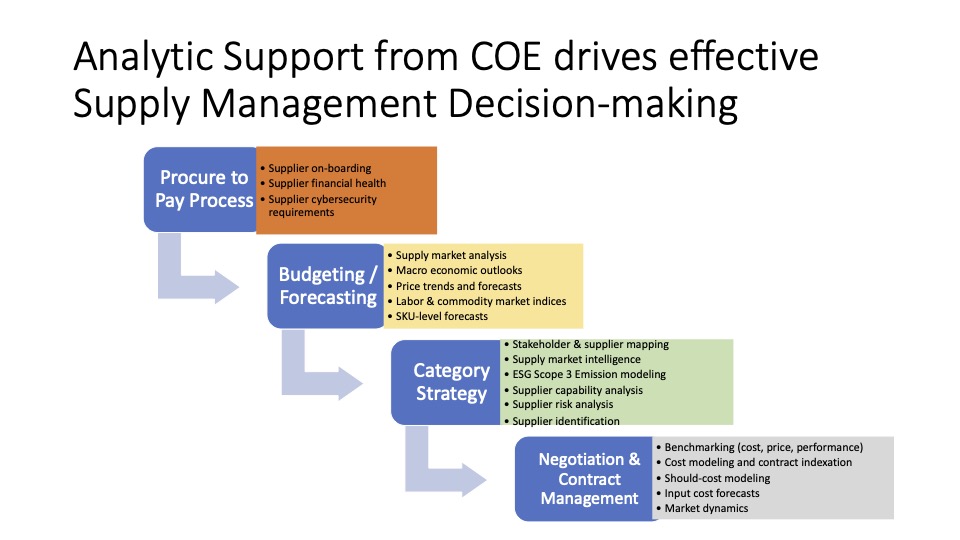The Role of Centers of Excellence in Supply Chain Transformation

In 2025, we will likely see many supply chain organizations creating multi-purpose COEs that carry out several different processes. Organizations may begin with a COE focused on transactional work around payables and invoices, but which then builds on this capability to engage in more strategic activities over time. The procure to pay focus may continue, but other types of COE activities are layered on top, building on progressively more sophisticated activities such as KPI development, category intelligence support, risk management, contract management, and predictive analytics.
As the different activities of a COE mature, the degree of influence and control over activities becomes lower. This is because the tasks themselves become less structured, and require greater levels of curiosity, innovation, and exploratory research, with inquisitive minds seeking to develop innovative ways of representing data to create insight for supply managers. Individuals at this level are highly skilled at digging into data, understanding business relationships, and engaging well with key stakeholders to solve the many problems of supply chain risk, cost modeling, and predictive scenario development for supply chain design. For example, one executive interviewed described how an initial P2P COE developed was an offshore captive service. The structure used in this approach was intended to not just conduct labor arbitrage, but to also develop core skills in the P2P space through a captive approach:
Our sourcing COE is responsible for the low- and medium-complexity deals — where the key outcomes desired include quicker turnaround time, throughput, and extracting any value you can. At our company, fifteen percent of our deals make up 85 percent of the value, so there is a long tail on many deals that we run through our COE. We evaluated whether to go with an offshore BPO with one of the big consultants, but decided against that. We already had a large presence in Punai and Bangalore (7000+), and recognized that we had to develop people over there to manage these types of transactions. We now have about 75 people, including two category managers that lead IT sourcing and contingent workforce management. They also perform P2P transactions, analytics studies, business intelligence, and other work.
In the P2P space, it is also important to note that the role of robotic process automation (RPA) and AI will further enhance the capabilities of COEs to efficiently manage transactional work. RPAs are able to handle supplier email inquiries and payment inquiries, for example, in an efficient and streamlined manner. A CPO for a transportation manufacturing equipment provider noted:
RPA will have a big impact on COEs, especially on the lower end of the system. You won’t need accounting payable supervisors anymore; that work will largely be done by bots. This will be a big step change — and will occur quickly in the next few years. We will also see increased application of sensing technology, like GPS on railcars and containers, and backup cameras that are recording all incidents and events and monitoring what is going on in supply chains.
In the early stages, many companies develop a COE to streamline procure-to-pay-activities, as well as accounts payable, contract reviews, and other manual transactional activities, which frees up time for category managers, as shown in the figure below. AI technologies may be very helpful in improving the efficiency of such processes. The goal of P2P COE as an important step in procurement transformation is to reduce the amount of transactional “work” from the daily workflow of procurement managers, allowing them to focus more on strategic category activities: market intelligence, risk analysis, cost-price analytics, etc. If managers are tied up checking on purchase orders, supplier invoices, payments, and RFPs, they have little time to work on the more important cost-impactful work.

For organizations further along the maturity curve, COEs will have to rely much more on human talent, for activities which are highly unstructured, and which requires a highly talented set of analysts. A good example of this is the development of supply market intelligence, and its counterpart, supply risk management. Both supplier intelligence and risk analysis are often highly unstructured decisions, which involve a lot of inference abilities, difficult decision-making, intuition, and analytic insight. Market intelligence analysis is often supported by third-party providers (e.g., Beroe, Spend Cube, GEP, and others), who combine pre-developed reports along with consultative services to provide deep insights into markets. My research indicates that two-thirds of COE staff are internal, and about one-third are outsourced. This creates a good mix of internal and external capabilities.
Market intelligence analysis is often assigned to category teams prior to renewal of a major category strategy or supplier RFQ/negotiation event, and sufficient time is required to plan for these events. One problem I frequently heard while researching this topic was that category managers were late in requesting these materials, and that sufficient time was not allowed for a COE to respond and prepare a solid report, especially given the backlog of work that already exists. For example, the typical timeframes required for developing different types of market intelligence by one organization increases based on the complexity of the category market conditions and the number of SKUs. These planning cycles should be communicated to category managers and senior executives, in order that an appropriate amount of time is allocated prior to the event for which the report is needed.
It is also imperative that organizations recognize the relevance of COE outputs to different sourcing processes and critical decision-making. The timeliness of COE outputs must be mapped to cycles of contract renegotiations, category strategy refreshes, budget planning cycles, and procurement spend analysis reporting. The timing associated with these different activities, in terms of the length of time to do so, should also be planned and coordinated across the different activities within each category, and stagged to the extent possible so the workload is not overwhelming.
COE’s will be an important organizational element for CPO’s that are intent on driving procurement transformation in 2025.
- Categories:
- Analytics
- Analytics
- Articles
- Artificial Intelligence in Supply Chain
- Big Data
- Category Management
- Commodities forecasting
- Contract Management
- Digital Supply Chain
- Director's Blog
- Emerging Issues in Supply Chain
- FLOW: How the Best Supply Chains Thrive
- Forecasting
- Global Supply Chain
- Hot Topics
- LIVING Supply Chain
- Procurement
- Procurement Process
- SCM Artificial Intelligenxe
- SCM Procurement
- Supply chain analytics
- Supply Chain From The Field
- Supply Market Intelligence


